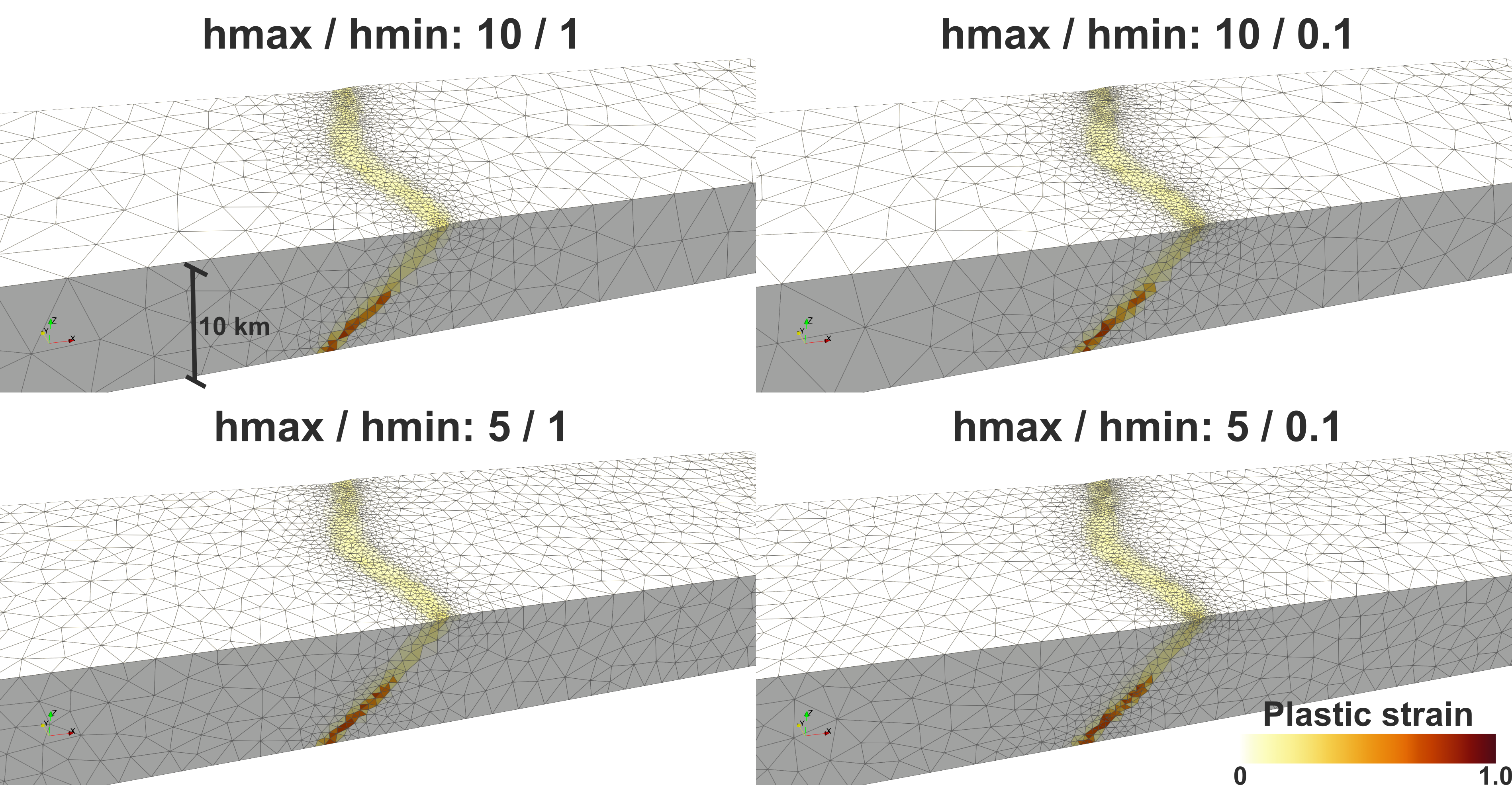Adaptive mesh refinement with MMG
In a nutshell,
-
Install MMG.
libmmg3d.aorlibmmg2d.ais expected to be available.- With minimal required dependencies, it should be straightforward to build MMG.
-
With
use_mmg = 1inMakefile, remeshing will use MMG for adaptive mesh refinement. -
The following two parameters control the maximum and minimum element size during remeshing. For instance,
mmg_hmax_factor = 10.0: The largest element will have an edge length 10 timesparam.mesh.resolutionmmg_hmin_factor = 0.1: The smallest element will have an edge length 0.1 timesparam.mesh.resolution
-
compute_metric_field()inremesh.cxxis currently hardwired to use plastic strain () to scale element size from to as 1/(1+).- In the future, users should be able to change the factor 10 or the function form itself.
-
Note that since can only increase, the total mesh size will grow with it.
- To maintain a certain mesh size, mesh optimization is needed.
- DES3D is currently hardwired to provide a 'solution' filed see below and thus perform remeshing.
- It should be a user option whether to provide a solution field or not.
Screenshots
examples/core-complex-mmg.cfgparam.mesh.resolution: 1 km
Technical details
Parameters for MMG
mmg_debug: Turn on/off debug mode. In debug mode, MMG checks if all structures are allocated.mmg_verbose: Level of verbosity, -1 to 10.mmg_hmax_factor: Positive number. The maximum possible element size set to behmax * param.mesh.resolutionmmg_hmin_factor: Positive number. The minimum possible element size set to behmin * param.mesh.resolutionmmg_hausd_factor: Global Hausdorff distance (on all boundaries in the mesh). Roughly speaking, allowed difference of the boundary before and after mesh refinement or optimization.
For more MMG parameters, refer to https://mmgtools.github.io/libmmg3d_8h.html#a964a06109019542d04f12263c3fae24d
For instance,
mmg_debug = 0
mmg_verbose = 0
mmg_hmax_factor = 10.0
mmg_hmin_factor = 1.0
mmg_hausd_factor = 0.01
Using MMG for remeshing
One needs to set usemmg to 1 in Makefile:
usemmg = 1
In Makefile, the following build parameters are set:
ifeq ($(usemmg), 1)
# path to MMG3D header files
MMG_INCLUDE = $(HOME)/opt/mmglib/include
# path of MMG3D library files, if not in standard system location
MMG_LIB_DIR = $(HOME)/opt/mmglib/lib
MMG_CXXFLAGS = -I$(MMG_INCLUDE) -DUSEMMG
ifeq ($(ndims), 3)
MMG_LDFLAGS = -L$(MMG_LIB_DIR) -lmmg3d
else
MMG_LDFLAGS = -L$(MMG_LIB_DIR) -lmmg2d
endif
ifneq ($(OSNAME), Darwin) # Apple's ld doesn't support -rpath
MMG_LDFLAGS += -Wl,-rpath=$(MMG_LIB_DIR)
endif
endif
ifeq ($(usemmg), 1)
CXXFLAGS += $(MMG_CXXFLAGS)
LDFLAGS += $(MMG_LDFLAGS)
endif
When USEMMG is defined during the build process with -DUSEMMG, remesh() function calls optimize_mesh(), not new_mesh().
void remesh(const Param ¶m, Variables &var, int bad_quality)
{
...
#ifdef THREED
#if defined ADAPT || defined USEMMG
optimize_mesh(param, var, bad_quality, old_coord, old_connectivity,
old_segment, old_segflag);
#else
new_mesh(param, var, bad_quality, old_coord, old_connectivity,
old_segment, old_segflag);
#endif
...
optimize_mesh()
Options for the bottom boundary
The option param.mesh.remeshing_option determines what to do to the bottom boundary during remeshing. However, it does not directly control how MMG performs mesh optimization.
/* choosing which way to remesh the boundary */
switch (param.mesh.remeshing_option) {
case 0:
// DO NOT change the boundary
excl_func = &is_boundary;
break;
case 1:
excl_func = &is_boundary;
flatten_bottom(old_bcflag, qcoord, -param.mesh.zlength,
points_to_delete, min_dist);
break;
case 2:
excl_func = &is_boundary;
new_bottom(old_bcflag, qcoord, -param.mesh.zlength,
points_to_delete, min_dist, qsegment, qsegflag, old_nseg);
break;
case 10:
excl_func = &is_corner;
break;
case 11:
excl_func = &is_corner;
flatten_bottom(old_bcflag, qcoord, -param.mesh.zlength,
points_to_delete, min_dist);
break;
case 12:
flatten_x0(old_bcflag, qcoord, points_to_delete);
break;
default:
std::cerr << "Error: unknown remeshing_option: " << param.mesh.remeshing_option << '\n';
std::exit(1);
}
Workflow during remeshing with MMG
- Initialization
- Mesh building in MMG5 format
- Solution (i.e., metric) field building
- When a solution filed is provided, MMG's mesh optimization, re-shaping element respecting the original sizes, does NOT occur. Instead, new elements are created as desired according to the parameters.
- The current default mode in DES3D is to provide a solution field.
- For this purpose, there is a customizable function,
compute_metric_field()inremesh.dxx. More about this function below.
- Mesh optimization
- Mesh-related data update using the optimized MMG5 mesh
compute_metric_filed()
This is a short function that converts one of the data filed to a metric field. Currently, it scales plastic_strain to a solution field. A solution, h, at a node is directly used for determining an element size.
h ranges between hmin and hmax.
we get
- h = hmax = 2 km where .
- 2 km / (1+10 ) where .
- 100 m where .
Here is the full code listing:
void compute_metric_field(const Variables &var, const Param ¶m, const conn_t &connectivity, const double resolution, double_vec &metric, double_vec &tmp_result_sg)
{
/* dvoldt is the volumetric strain rate, weighted by the element volume,
* lumped onto the nodes.
*/
std::fill_n(metric.begin(), var.nnode, 0);
#ifdef GPP1X
#pragma omp parallel for default(none) shared(var,param,connectivity,tmp_result_sg,resolution)
#else
#pragma omp parallel for default(none) shared(var,param,connectivity,tmp_result_sg)
#endif
for (int e=0;e<var.nelem;e++) {
// const int *conn = connectivity[e];
// double plstrain = resolution/(1.0+5.0*(*var.plstrain)[e]);
// tmp_result_sg[e] = plstrain * (*var.volume)[e];
// tmp_result_sg[e] = plstrain * (*var.volume)[e];
// resolution/(1.0+(*var.plstrain)[e]);
double metric = param.mesh.mmg_hmax_factor*param.mesh.resolution / (1.0 + 10.0*(*var.plstrain)[e]);
metric = std::max(metric, param.mesh.mmg_hmin_factor*param.mesh.resolution);
tmp_result_sg[e] = metric * (*var.volume)[e];
}
#pragma omp parallel for default(none) shared(var,metric,tmp_result_sg)
for (int n=0;n<var.nnode;n++) {
for( auto e = (*var.support)[n].begin(); e < (*var.support)[n].end(); ++e)
metric[n] += tmp_result_sg[*e];
metric[n] /= (*var.volume_n)[n];
}
}